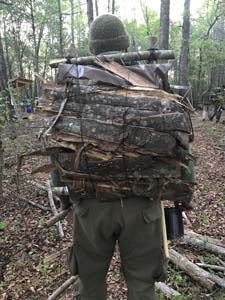 One thing that is an undeniable truth when practicing bushcraft or working outdoors, is cordages of some type will eventually be needed. There is a reason I have deemed this element important enough to include in the 5Cs for Survivability (Cutting Tool, Combustion Device, Cover, Container, Cordage). Just looking at this list alone shows its usefulness in creating objects we may damage or loose in an emergency. It could be used to wrap the handle or repair the handle of a tool like a knife. Making a primitive friction fire by bow and drill is impossible without strong cordage. Containers made from natural material, like bark, can be laced together with cordage. Cover elements require the lashing and tying of material where cordage is of certain use as well.
One thing that is an undeniable truth when practicing bushcraft or working outdoors, is cordages of some type will eventually be needed. There is a reason I have deemed this element important enough to include in the 5Cs for Survivability (Cutting Tool, Combustion Device, Cover, Container, Cordage). Just looking at this list alone shows its usefulness in creating objects we may damage or loose in an emergency. It could be used to wrap the handle or repair the handle of a tool like a knife. Making a primitive friction fire by bow and drill is impossible without strong cordage. Containers made from natural material, like bark, can be laced together with cordage. Cover elements require the lashing and tying of material where cordage is of certain use as well. While it is possible to make cordage from natural materials in a pinch, synthetic rope, cord, or string that you carry with you is more expedient and will hold up to rigerous use better. Natural cordage making is a useful skill, but it is a time consuming process.
While it is possible to make cordage from natural materials in a pinch, synthetic rope, cord, or string that you carry with you is more expedient and will hold up to rigerous use better. Natural cordage making is a useful skill, but it is a time consuming process.Even if we look at the emergency scenario, cordage is an essential element. Understanding the art of making cord with natural plants and inner bark is essential to our bushcraft library, but in reality, for most uses, carried cordage is a much faster option. Don’t get me wrong, we should all practice the skill of making natural cordages, but again this is more for fun than true practicality. There are several types of cord and rope we can carry and much of this should be dictated by the uses we plan to employ, but also bearing in mind uses we may not plan on. So, this element of our kit should also be as versatile as possible.
 Like the other elements, we should probably layer this within our kit and carry it in multiple places, including a hank of it in our pockets, but we should also have multiple types of cord and rope like we have several ways of starting fire or several cutting tools for different tasks.
Like the other elements, we should probably layer this within our kit and carry it in multiple places, including a hank of it in our pockets, but we should also have multiple types of cord and rope like we have several ways of starting fire or several cutting tools for different tasks. Even though 550 paracord is in the spotlight in most survival books and articles, tarred bank line is far more versatile and can be used for everything from lashing, ridgelines for shelter, to weaving a fishing net or hammock.
Even though 550 paracord is in the spotlight in most survival books and articles, tarred bank line is far more versatile and can be used for everything from lashing, ridgelines for shelter, to weaving a fishing net or hammock.The type of cord we hear the most about today for use in “Survival Kits” is probably parachute type 550 cord. This is a great choice, but I am pretty certain this choice has been somewhat ingrained into us through military-style survival manuals over the years. And while it has good tensile strength and is very durable, it can become quite a pain to deal with the inner fibers of the mantle when attempting to break it down for use as fishing lines and repair threads. For this reason, I recommend that the majority of heavy cord or rope you carry be a twisted style multi strand rope that can be broken down easily to smaller workable fibers. I generally have about 25’ of 550 cord in my kit, used mainly for ridge lines when setting up a tarp.
 The line I carry the most of and this is generally a 1-pound roll, is called bank line or tarred mariners line. This line is specifically designed for making gill nets for fishing. It is actual rope, so that is can be broken down easily into smaller fibers for things like sewing and repair or reducing the diameter for fishing lines, etc. It comes in multiple sizes, with the #36 what I find the most useful and this is approximately 320-pound test. The smaller diameters like #8 and #6 work well for main body work in nets, but the #36 works well for lashing structures and making camp apparatus, but still can be broken down into three very strong fibers if desired.
The line I carry the most of and this is generally a 1-pound roll, is called bank line or tarred mariners line. This line is specifically designed for making gill nets for fishing. It is actual rope, so that is can be broken down easily into smaller fibers for things like sewing and repair or reducing the diameter for fishing lines, etc. It comes in multiple sizes, with the #36 what I find the most useful and this is approximately 320-pound test. The smaller diameters like #8 and #6 work well for main body work in nets, but the #36 works well for lashing structures and making camp apparatus, but still can be broken down into three very strong fibers if desired.Other types of cordages that I sometimes use are things like mule tape and tubular webbing. Mule tape, which is actually a device used for pulling electric wire through conduit, has a tensile strength of about 1,800 pounds and is very lightweight, so 100 feet of this stuff takes up little room and has quite a few advantages, from hanging hammocks to even building rope bridges. The main downfall of mule tape I have found, is it will cut itself if used for rope tackles and requires the addition of a carbineer or similar pulley, to keep the line from direct friction contact with itself. But, for many things, including rope ladders and the like, it is ideal.
Tubular webbing, used for climbing, comes in a 1-inch width and while it takes up more room and has more weight than mule tape, it also has a substantially higher tensile strength and works well for hammock suspensions and ridgelines as well as rope ladders. Natural fiber cordage, like Manila and Sisal and even Hemp, are a good choice, although much heavier than synthetics and much more susceptible to weather and UV damage. It also takes a larger diameter of this cord to achieve the same tensile strength as synthetics. I have found for the majority of short-term use in camp, that a combination of 25 feet of 550 cord and a 1-pound roll of #36 bankline will do just about anything I need, from building shelter, to fishing and primitive trapping, as well as using it for gear repair and sewing as needed, when a good sail-maker’s needle is handy.
 Whatever you decide, it is easy enough to see that cordage is worth the effort and weight to carry when the alternative is to manufacture it from the landscape. It is not hard to make a few feet of reverse wrap 2-ply cordage from inner tree bark in a short amount time, but to make 300-400 feet that could otherwise be easily carried in a 1-pound roll of bankline and won’t be near as strong, would take some time for sure.
Whatever you decide, it is easy enough to see that cordage is worth the effort and weight to carry when the alternative is to manufacture it from the landscape. It is not hard to make a few feet of reverse wrap 2-ply cordage from inner tree bark in a short amount time, but to make 300-400 feet that could otherwise be easily carried in a 1-pound roll of bankline and won’t be near as strong, would take some time for sure.Part of the reason for these first 5 Cs we discuss is their difficulty to recreate from natural material in a short time as well as the possibility of the necessity for specialized material sources and skills to get the job done. Being prepared is the key to short-term survival and building a kit that meets your direct needs and with items that perform multiple tasks well, is what’s truly important to understand.
About the Author - Dave has been published in Self Reliance Illustrated, New Pioneer, and American Frontiersman, Trappers World, and has appeared on the cover of Backwoodsman Magazine. Dave’s book BushCraft 101 is a two-time NY Times Best Seller. In addition to writing about survival, Dave is the Co-Owner and Supervising Instructor of The Pathfinder School in SE Ohio, the United States Premier School for Self Reliance. The Pathfinder School is listed as one of the top 12 Survival School in the U.S. by USA TODAY. Dave holds a Bachelor’s Degree in Wilderness Ministry from Frontier Christian University is certified in Advanced Search and Rescue, Wilderness First Aid/CPR, as an Expert Trapper by the Fur Takers of America, and holds Basic and Intermediate Certificates from the International School of Herbal Arts and Sciences.

